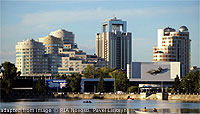Russia’s “Third Cultural Center,” Yekaterinburg

(Moscow Times – themoscowtimes.com – John Freedman – May 27, 2013)
John Freedman has been the theater critic of The Moscow Times since its inception in 1992.
Natalya Druzhinina is the director of development for the Yekaterinburg Young Spectator Theater. She is also an artistic and executive director of the Real Theater festival, which is organized biannually by the Young Spectator Theater. She lives in Yekaterinburg, was educated there and she knows the culture of her city back and forth, up and down.
I travelled to Natalya’s home city last week with a group of Americans participating in a program called Beyond the Capitals: Not the Usual Suspects, which is designed to bring together Russian and American theater makers who do not live or work in the standard “culture capitals” of their respective countries. On a beautiful pre-summer day we took a trip to Ganin Pit (Ganina Yama), the place where a monastery has grown on the site where the remains of the last Russian royal family members were discovered in 1991. After we viewed the simple, moving hole in the ground which once contained the Tsar’s family’s remains, I asked Natalya to sit down and talk a little about Yekaterinburg culture.
Druzhinina calls Yekaterinburg Russia’s “third cultural center” after Moscow and St. Petersburg, noting that it is home to Nikolai Kolyada’s mighty Kolyada Theater, Natalya Baganova’s world renowned Provincial Dances company, as well as the Young Spectator Theater, about which Druzhinina wrote a thesis when she was a university student.
I will say more specifically about the Kolyada Theater next week, but it seems useful to repeat Druzhinina’s words that this venue is a “site-specific” entity that “is totally connected with our city and its culture and background,” while she points out that Baganova’s company purposefully erases signs of its Urals Mountain origin in order to achieve an image that is more “cosmopolitan and universal.”
With a motto of “from childhood and forever,” the Young Spectator Theater is quite serious about its mission as a children’s theater. It specifically mounts performances for children, aged three to five, a group, says Druzhinina, which no theaters besides puppet theaters every worry about. “We try to conduct a serious conversation even from this small age,” she declares.
The theater’s “target age” is children from eight to 12, while there are also productions and special programs aimed at teenagers, who are especially “hard to work with.”
“We invite them to participate in various projects,” Druzhinina says, “for example, a theatrical disco that happens every Christmas and New Years.”
Nevertheless, the theater has made its national reputation under such directors as Anatoly Praudin (in the 1990s) and Vyacheslav Kokorin (in the early 2000s) by staging memorable productions of non-children’s theater.
It was under the leadership of Kokorin that the theater instituted a program called Behind the Concrete Wall. Shows staged in this program are deemed adult fare and are banned for spectators under 18. Most often these works are productions of contemporary drama, both Russian and foreign. It was as part of this program that the first significant production of the Presnyakov brothers’ most famous play, “Playing the Victim,” was originally produced in Russia.
According to Druzhinina, this program is popular with university students and “others who are interested in contemporary drama.”
“We were the first theater in Yekaterinburg to begin doing seminars in contemporary drama in 2001,” Druzhinina declares.
Almost every year the theater presents new texts and plays in the form of works-in-progress that are rehearsed for three days and then presented to the public. These seminars serve two purposes, Druzhinina explains, “to inform the public of new texts and to make new productions for our theater.”
Still another thematic project is the Theater Near the School Blackboard, for which the theater was given a special grant by the city.
The essence of the program is that “we produce short pieces based on books that students study in school,” Druzhinina notes. These performances, which are intended to “make classical books clearer for children,” run just 45 minutes, the same amount of time as a typical literature lesson in school.
One of the most important projects hosted by the Yekaterinburg Young Spectator Theater is the Real Theater festival. It was created in 1990 and is considered one of the three most important festivals on the Russian national theater circuit, the others being the Golden Mask Festival in Moscow and the Baltic House festival in St. Petersburg.
Druzhinina asserts that, while each festival may bring in special guests, the purpose of the festival is not to show off “stars or famous names from Moscow or St. Petersburg,” but rather to exhibit the real state of Russian theater throughout the country every two years.
